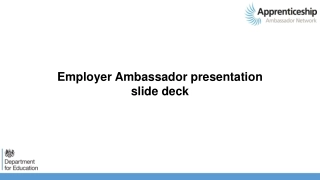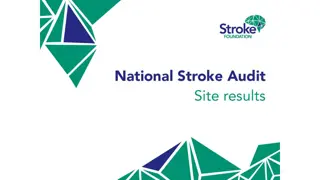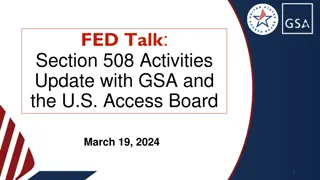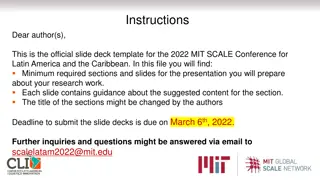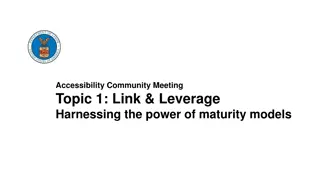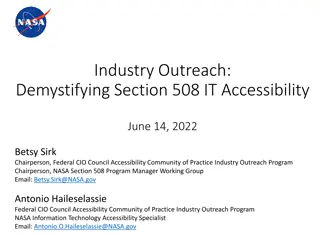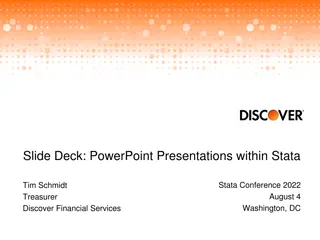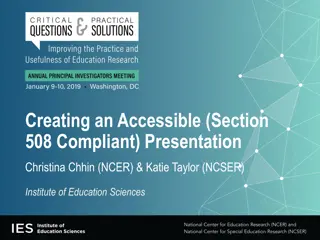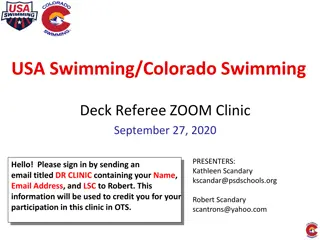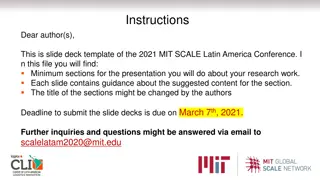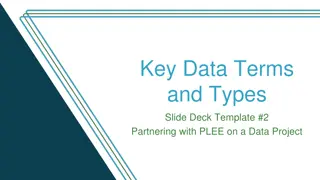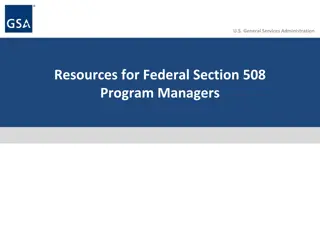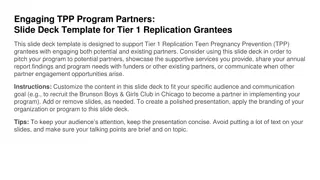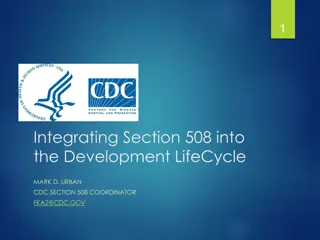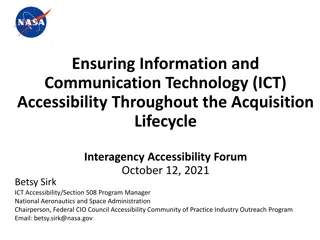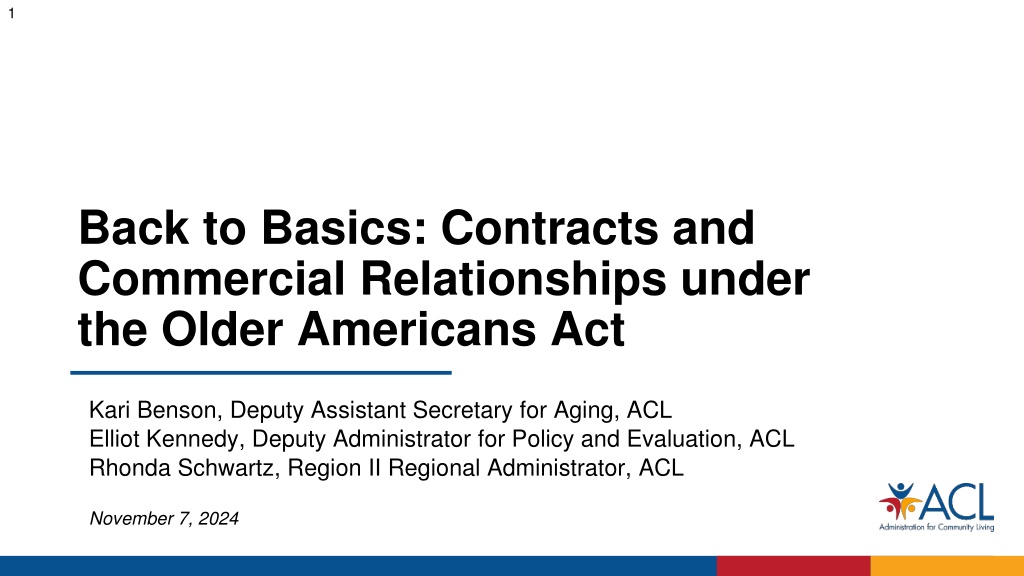
Contracts and Commercial Relationships under the Older Americans Act
Explore the basics of contracts, commercial relationships, and regulations under the Older Americans Act in this informative webinar presented by key authorities from ACL. Gain insights into policy guidance, sample forms, and the significance of Section 212 agreements. Enhance your understanding of leveraging resources to benefit older adults effectively.
Download Presentation

Please find below an Image/Link to download the presentation.
The content on the website is provided AS IS for your information and personal use only. It may not be sold, licensed, or shared on other websites without obtaining consent from the author. Download presentation by click this link. If you encounter any issues during the download, it is possible that the publisher has removed the file from their server.
E N D
Presentation Transcript
1 Back to Basics: Contracts and Commercial Relationships under the Older Americans Act Kari Benson, Deputy Assistant Secretary for Aging, ACL Elliot Kennedy, Deputy Administrator for Policy and Evaluation, ACL Rhonda Schwartz, Region II Regional Administrator, ACL November 7, 2024
2 Housekeeping This webinar is being recorded The recording and slides from today's webinar will be posted in the coming weeks at https://acl.gov/OAArule All attendees are in listen only mode & chat feature is disabled. Place all questions in the Question & Answer (Q&A) box Questions will be answered live, time permitted Communication Access Realtime Translation (CART) and American Sign Language (ASL) services are provided. If needed, please click the appropriate option along the bottom of your Zoom screen.
3 Welcome Kari Benson Deputy Assistant Secretary for Aging, Administration on Aging, ACL
4 Agenda Background Sample State Unit on Aging (SUA) Policy & Form Contracts and Commercial Relationships (CCR) Guidance Older Americans Act (OAA) Final Rule Provisions Summary and Resources Please note: When a hyperlink is provided on a slide, the notes section will include the full website link.
5 Background
6 Back to Basics: What does it mean? Why now? What Meeting the mission and vision of the OAA by holistic program management: Program, fiscal, data, evaluation, training, communications, policies & procedures (P&P), all in alignment; Maintaining integrity of advocacy activities; and Targeted, effective, efficient activity. Why Coincides with the first comprehensive update to OAA program regulations in 36 years Emerging from the COVID-19 pandemic Recent spate of retirements New and developing business opportunities Increased interest in stewardship of public funds
7 Announcement of Sub-Regulatory Guidance and Sample Policy & Form Please visit https://acl.gov/OAArule to view: ACL s Sub-Regulatory Guidance With APPENDIX A: Sample SUA Policy and Procedure for Prior Approval of Section 212 Agreements
8 Understanding Section 212 of the OAA (1) Terminology: Contracts, Commercial Relationships, Agreements Intent: to leverage all available resources to expand access to services for older adults Considerations: Conflicts of interest (COI) Strength of the federally-designated aging services network Transparency Oversight: Grantee and sub-grantee relationship
9 Sample SUA Policy & Form
10 Sample SUA Policy for Prior Approval of Section 212 Agreements The following policy, procedure, and prior approval forms are not required documents. They are sample documents for SUAs, in consultation with area agencies on aging (AAAs), to consider adapting. (Adapt, don t adopt!) Through this sample policy, the SUA has decided to: Categorically approve certain kinds of agreements, and Review other kinds of agreements more closely In these sample documents, blue text provides explanations and describes alternative approaches that an SUA, in consultation with AAAs, could take.
11 Sample SUA Policy (1) The SUA encourages AAAs to establish comprehensive and coordinated systems for supportive, nutrition, and other services for older adults in our state by leveraging resources beyond OAA funding. Through this policy, the SUA intends to facilitate increased access to aging services in our state while ensuring responsible oversight of federal funds and protecting the integrity of our aging services network. Consistent with section 212 of the OAA, AAAs who seek to establish agreements to serve individuals or entities not otherwise receiving services under the Act must obtain prior approval from the SUA. This policy applies to agreements with any entity for a AAA to provide goods or services in exchange for reimbursement or other financial consideration, with the expectation that the agreement will result in profit and reimbursement of initial costs.
12 Sample SUA Policy (2) For agreements involving multiple AAAs, one entity may submit information for prior approval on behalf of the group. The anticipated expectations of each AAA must be clear. Service providers sub-contracted for work to execute an agreement are not required to separately seek prior approval. AAAs must incorporate standard language related to COI and compliance with SUA data use policies. The SUA has established this streamlined P&P to expedite the prior approval process as much as possible. Use of Older Americans Act Funding: Consistent with section 212 of the OAA, AAAs may use OAA funding to develop or initiate section 212 agreements. All section 212 agreements must incorporate a guarantee that any OAA costs used in the development will be reimbursed to the AAA by the third-party entity. In addition, any amount of payment to the AAA that exceeds this must be used to provide, or support the provision of, OAA services.
13 Sample SUA Policy: Types of Agreements (1) Through this policy, the SUA categorically pre-approves the following types of agreements, contingent on receipt of the minimum information outlined in the prior approval form: Agreements with local, state, and federal governmental entities; Agreements with other AAAs or AAA associations; and Agreements with entities with which a AAA has a long-standing existing business relationship (of three years or more). Note: AAAs that have received an audit report with financial findings within the previous twelve months are not eligible for the categorical approval of agreements. The SUA, in consultation with AAAs, may decide to offer blanket prior approval for categories of CCRs that pose very little risk, such as those listed above The SUA also always retains the ability to audit or request supporting documentation if concerns arise. In addition to categorical approval, the SUA might decide to offer a review and approval process for distinct categories of CCRs, such as those listed on the next slide. In all cases, SUAs must still receive minimum information about the CCRs prior to their establishment.
14 Sample SUA Policy: Types of Agreements (2) The SUA will also approve the following types of agreements, subject to review of the required prior approval forms: A single agreement with an entity (or multiple entities) to provide specific services; A category or type of agreement with a specific entity or a type of entity for the AAA to provide specific services (including through private pay arrangements); and A category or type of agreement with a type of entity (or multiple entities) for the AAA to provide a broad category of services. The key distinction between these categories and those listed on the previous slide is that the SUA must review information submitted by AAAs prior to approval of these agreements, whereas for agreements that are categorically approved under this policy, the SUA need only receive information from the AAA.
15 Sample SUA Policy: Prior Approval Procedure Prior Approval Procedure: AAAs must submit the following information for any new potential agreements that require prior approval. AAAs may submit the prior approval form whenever necessary to receive approval prior to establishing an agreement subject to prior approval under section 212 of the OAA: 1. The name of OR type of the entity (or entities) with which it intends to establish agreement(s); 2. The nature of the agreement(s), including the specific service(s) OR the types of services to be provided under the agreement(s); 3. An estimate of the proposed costs incurred from all sources, including the estimated amount of OAA and state funds that will be used in implementing the agreement (e.g., administrative overhead, data systems, and/or staff time); 4. The duration of the agreement; 5. The completed risk-screening form; and 6. Signed assurances. Items in 1., 2., and 3. above represent the minimum information that the SUA must receive to provide prior approval of an agreement under section 212. The SUA may request additional information (e.g., the items in blue text) AAAs have ongoing obligations under the OAA to identify and address COI and must operate consistent with the assurances in sections 212 and 306, and elsewhere in the OAA.
16 Sample SUA Policy: Risk-screening and Assurances Risk-screening: AAAs must assess prospective agreements for risk, according to the criteria identified in this policy. If one or more of the identified risks are present, the SUA will not approve without discussion with or the provision of further information from the AAA. The SUA, in consultation with AAAs, might decide to require AAAs to provide additional information when specific risks are identified. The SUA might alternatively decide not to assess specific risks at all. The scenarios in this policy are examples of potential risks that may lead SUAs to review a potential agreement more closely. SUAs should adapt any risk screening to the specific needs of their state. SUAs could also decide not to incorporate these specific criteria into their policy, and instead only list them in the prior approval form. Assurances: AAAs must provide assurances of compliance with certain requirements under the Act, which are listed in the prior approval form. AAAs must also incorporate standard language related to COI into each of the prospective agreements for which they are seeking approval. As with risk-screening, the SUA has discretion to decide whether to require assurances specific to each agreement as part of the prior approval process. Regardless, AAAs have ongoing obligations under the OAA to identify and address COI and must operate consistent with the assurances in section 306 and throughout the OAA.
17 Sample SUA Form for Prior Approval of Section 212 Agreements Contact Information Information about the prospective agreement(s) Name or type of entity or entities (If a non-disclosure agreement prevents you from disclosing the name of the entity, please disclose the type of entity) Specific services OR types of services to be provided Will multiple AAAs have contractual obligations under this agreement or these agreements? If yes, please identify the AAAs and describe the obligations of each Will OAA funds or resources (e.g., administrative overhead, data systems, staffing) be used in implementing the agreement(s)? If yes, estimated OAA costs incurred Estimate of total costs incurred
18 Sample SUA Form: Categorical Approval Approval Criteria: 1. Pre-approved categories of agreements Is this proposed agreement/are these proposed agreements (check all that apply): o With a local, state, or federal governmental entity or entities? o With other AAAs or AAA associations? o With an entity or entities with which the AAA has a long-standing existing business relationship (of three years or more)? If a AAA checked any of the items in #1, skip to #3 to review the assurances and provide a signature. No additional SUA review is required; these categories of agreements are considered approved upon submission of this form.* *AAAs that have received an audit report with financial findings within the previous twelve months are not eligible for the categorical approval of agreements, including the types of agreements listed above. Instead, AAAs in such situations must complete this entire form for SUA review for each agreement for which they are seeking approval.
19 Sample SUA Form: Risk Assessment (1) Risk Assessment: To assess for any potential risks associated with the proposed agreement(s), please check mark any of the potential risks listed that are relevant to this application for prior approval. Please provide an attachment describing, for each potential risk that has been checked, either (a) why the AAA does not believe the criteria presents a risk in the case of the proposed agreement(s) or (b) how the AAA intends to mitigate any actual risk. The SUA may request further discussion or documentation prior to making a final determination about the agreement(s). The SUA could choose from a wide range of options in assessing the risk associated with agreements. The SUA could choose to ask for disclosure and proposed mitigation plans. The SUA could also decide to ask for attestations that any potential risks have been identified and mitigated.
20 Sample SUA Form: Risk Assessment (2) Examples: The AAA does not have an approved area plan; The AAA is on a corrective action plan (CAP) or has received notice of being out of compliance with its area plan and is in the process of entering into a CAP; The AAA has had carryover of OAA funding exceeding the SUA s policy and/or reallotment of funds within the last three fiscal years; There is current or pending litigation involving the AAA; There are COI involving the AAA that have not been removed or remedied If you check-marked any of above items, please complete the rest of this form and submit it to the SUA. The SUA may contact you to discuss or request additional information on this application prior to issuing a decision.
21 Sample SUA Form: Assurances and Signatures Assurances: By signing below and submitting this form, the AAA attests to the truth of the following assurances: COI (organizational and individual) Section 212(a) & (b) Section 306(a) Section 306(a)(13) annual disclosure requirements Compliance with SUA data use policies Signatures
22 CCR Guidance
23 Defining Contracts and Commercial Relationships Contracts and commercial relationships, or CCR, is a broadly encompassing phrase Includes contracts, business arrangements, agreements, business transactions or any other term that an organization might use to describe a business arrangement between one or more entities ACL does not distinguish between a contract and a commercial relationship; the same requirements apply, regardless of how an organization defines the agreement
24 State Approval of AAA Activities As recipients of federal funding under the OAA, SUAs ultimately bear responsibility for determining whether AAAs, as the designated subrecipients of federal funding, comply with federal requirements. Beyond general oversight responsibilities, the OAA establishes two mechanisms for SUAs to provide advance approval of AAA activities: First, SUAs must develop a policy and process for approving section 212 agreements. This process must be readily available for AAAs seeking approval for activities. Second, in addition to an approval process specific to section 212 agreements, we also encourage SUAs to incorporate approval of section 212 agreements into the area plan approval process.
25 Section 212 Requirements v. The Area Plan Process (1) SECTION 212 REQUIREMENTS If AAAs want to enter into section 212 agreements, they must receive prior approval. Through section 212, AAA may support a single activity or a category of activities through contracts with other entities. AREA PLAN PROCESS AAAs must receive prior approval through the area plan to use OAA funding to support a category of activities through contracts with service providers. Prior approval OAA funding may or may not be involved in these agreements. For AAAs to directly provide certain Title III services using OAA funding, prior approval is required from the SUA, consistent with sections 307(a)(8)(A) of the OAA and 45 Code of Federal Regulations (CFR) 1321.65(b)(7). Occurs every 2-4 years, as determined by the SUA, with annual updates and adjustments as needed. After receiving prior approval for section 212 agreements, AAAs may directly provide services. Providing direct services Prior approval process should be available at any time. Frequency of approval Does not require public input or advisory council review. Requires public input and advisory council review. Public input
26 Section 212 Requirements v. The Area Plan Process (2) SECTION 212 REQUIREMENTS AREA PLAN PROCESS After approval of the area plan, requires the annual disclosure of the identity of all entities with which AAA has CCRs to provide services to older adults. This disclosure requirement applies to section 212 agreements as well. Prior to approval, requires disclosure of certain minimum information, but not necessarily the identity of an entity. Disclosure of specific information Disclosure of specific minimum information is required before an agreement can be established: Typically, SUAs approve general activities in the area plan, rather than approving of specific agreements to facilitate the provision of Title III services. Name or type of entity or entities with which AAA intends to contract Nature of the agreement(s) (including specific services or types of services to be provided) Estimate of the proposed costs to be incurred Minimum information required for approval Disclosure of specific information about agreements to conduct area plan activities generally occurs after an agreement has been established. This information would need to be incorporated into the area plan process in order to use that process to approve of section 212 agreements.
27 Which Agreements Require Prior Approval Section 212 of the OAA permits AAAs to enter into agreements to provide services to individuals or entities not otherwise receiving services under this Act. AAAs must receive prior approval from the SUA before entering into a section 212 agreement. Note: Section 212 applies equally to agreements executed with and without OAA resources. SUAs are ultimately responsible for determining whether a CCR is an agreement that requires prior approval under section 212.
28 Questions To Ask In Determining Which Agreements Require Prior Approval Question 1: What is the funding source? Question 2: Who are the clients that will be served through the agreement? How is the AAA determining who is eligible for these services? Question 3: What are the services being provided?
29 What is the funding source? Non-OAA funding An agreement is subject to prior approval under section 212 if a AAA is receiving a non-OAA source of funding to provide or facilitate the provision of services. OAA funding An agreement is not subject to prior approval under section 212 if a AAA is using OAA funding to pay another entity (i.e., a service provider) to provide OAA services to OAA clients, in accordance with its area plan. An agreement is not subject to prior approval under section 212 if a AAA is using OAA funding to pay an entity to meet the administrative needs necessary to enable the AAA to fulfill its obligations under the OAA.
30 Who are the clients that will be served through the agreement? How is the AAA determining who is eligible for these services? If the AAA is arranging for services to be provided to a group of clients identified by another entity, the agreement is subject to prior approval under section 212. This is true even if the clients would be eligible for the AAA s Title III OAA services under the Act. If the AAA is arranging to provide specific services to a subset of existing OAA clients, but a third-party entity establishes the criteria for determining who among the clients will receive services, the agreement is subject to prior approval under section 212.
31 What are the services being provided? Non-OAA funded services If the services are only available to private pay clients or entities, the agreement is subject to prior approval under section 212. If the AAA is providing (or facilitating the provision of) allowable OAA services to individuals who do not meet the eligibility requirements under the Act, the agreement is subject to prior approval under section 212. OAA funded services If the AAA is providing (or facilitating the provision of) allowable OAA services and making them available through OAA funds to individuals that meet the eligibility requirements under the Act, the agreement is not subject to prior approval under section 212.
32 Determining Who is Responsible for Seeking Prior Approval for Section 212 Agreements Only the AAA needs to seek prior approval from the SUA to establish agreements between the AAA and another entity or type of entity for section 212 agreements. A group of AAAs may also collaborate as part of a larger arrangement, with one lead AAA primarily engaging with the third-party funder. In this case, at the discretion of the SUA, the AAAs could collectively seek prior approval. Must clearly lay out: Specific actions being taken by each AAA Consent of each AAA to participate in the arrangement
33 Section 212 Agreements with Non-Profit Entities If an agreement would be permitted under section 212 with a for-profit entity, an SUA has the discretion to permit similar agreements with non- profit entities so long as the other requirements of section 212 are met.
34 Using OAA Funds to Support Section 212 Agreements Section 212 permits AAAs to use OAA funds in a way that would not otherwise be allowable a AAA can use OAA funding to help support or develop an initiative that will then be supported by another funding source. If a AAA uses OAA funds in this way, any OAA funds must be reimbursed after the agreement becomes profitable. Any subsequent profits must be reinvested in OAA services, whether or not OAA funding was used as part of the agreement. In understanding what costs qualify as OAA funding, it is also important to quantify (and reimburse) other kinds of OAA-supported resources that were used to contribute to the new initiative. Some commonly overlooked OAA-funded resources include administrative overhead costs, use of OAA data systems, staffing and training costs that are wholly or partially funded by the OAA, and access to OAA client lists.
35 SUA Considerations in Developing Prior Approval Processes (1) SUA oversight P&Ps should be streamlined, transparent, not overly burdensome to either the SUA or AAAs, and commensurate to the degree of risk associated with a specific agreement. In developing their P&Ps, SUAs should consider the relevant government interests associated with reviewing a potential agreement, including, among others: Any potential COI and if appropriate firewalls exist to mitigate them; If the AAA is meeting existing obligations under the OAA; and Potential risks to the AAA, the aging services network, or to the individuals served by the AAA associated with the proposed agreement.
36 SUA Considerations in Developing Prior Approval Processes (2) Section 306(a) of the Act sets forth many relevant government interests in the form of assurances that AAAs must offer for area plan approval. SUAs might consider incorporating these assurances into their prior approval process, in addition to the requirements laid out in section 212(b) of the Act. SUAs are not parties to section 212 agreements. However, they are responsible for receiving sufficient information to approve of certain CCRs, consistent with sections 305(a)(1)(C), 306(a), 306(b), and 212(b)(1) of the Act. SUAs are also responsible for ensuring that the use of federal funds is reasonable and allocable, consistent with 45 CFR Part 75. Engaging in these responsibilities does not make the SUA a party to the CCR under review. Although SUAs have the discretion to request to review contract documents if they deem it necessary to determine whether the agreement may be approved, it should not generally be necessary to do so.
37 Minimum Information Required; Policy Examples At a minimum, SUAs must receive the following information from subrecipients prior to approving the agreement: The name(s) or type(s) of entity (or entities) with which the AAA intends to partner; The nature of the agreement(s), including the specific service(s) or types of services to be provided, and the proposed individuals to be served (or criteria to identify those individuals); Information about all specific or estimated costs incurred; and Specific assurances related to other requirements under section 212(b).
38 Oversight, Liability, and Addressing Challenges Activities described in section 212 of the Act (both successful and unsuccessful) are allowable costs under the OAA grant, so long as they comply with SUA P&Ps. The SUA must establish and follow P&Ps that are compliant with the 2024 final rule and comply with any other applicable requirements for recipients of federal grants. All new business endeavors represent some degree of risk; the P&Ps required by the 2024 final rule are intended to help mitigate, not eliminate, that risk. SUAs (as federal grantees) are ultimately responsible for ensuring the appropriate use of funds, while AAA subrecipients are predominantly responsible for using those funds to develop the aging services network. In addition to other oversight activities, the SUA can offer to provide technical assistance to a AAA to explain what would be necessary to approve a specific agreement, including discussing any acceptable firewalls or other remedies for COI that might be required.
39 OAA Final Rule Provisions
40 Compliance Date Compliance Date: October 1, 2025. As the final rule goes into effect, we look forward to providing technical assistance and engaging with stakeholders regarding implementation of the final rule. For SUAs that are unable to meet the October 1, 2025, compliance date, ACL will have a supportive corrective action plan process in place.
41 Layout of the Final Rule: Preamble (Sections I-III) & Regulatory Text We strongly encourage you to read the entire final rule. There are two basic sections: The first portion is the preamble and covers: background , explanation of the regulatory text, analysis and responses to public comments , and required regulatory analyses The second portion is the final regulatory text in full for 45 CFR parts 1321 (Title III), 1322 (Title VI), and 1324 (Title VII) On March 15, 2024, the regulation was published in the CFR, and can be found on www.ecfr.gov For a more detailed orientation to the final rule (e.g., webinars, additional resources), please visit ACL's OAA Regulations webpage: https://acl.gov/OAArule
42 State and Area Agency Policies and Procedures SUA P&Ps must be developed in consultation with AAAs, program participants, and other appropriate parties in the state ( 1321.9). AAAs are required to develop P&Ps in compliance with SUA P&Ps, including those under 1321.9, in consultation with other appropriate parties in the planning and service area (PSA) ( 1321.59).
43 Service Provider Policies and Procedures Section 1321.73 sets forth requirements to ensure AAAs and local service providers develop and implement P&Ps to meet requirements set by SUA P&Ps, in accordance with 1321.9. The section also specifies that the SUA and AAAs must develop monitoring processes, the results of which are strongly encouraged to be made available to the public. Doing so may be one way to ensure accountability and stewardship of public funds, as required by the Act.
44 1321.9(c)(2)(xiv) Contracts and Commercial Relationships (1) The SUA shall maintain requirements for contracts and commercial relationships (CCR), where: (A) SUAs, AAAs, and service providers may enter into CCR, subject to SUA and/or AAA policies and procedures and guidance as set forth by the Assistant Secretary for Aging, including through: (1) Contracts with health care payers; (2) Private pay programs; or (3) Other arrangements with entities or individuals that increase the availability of home- and community-based services and supports.
45 1321.9(c)(2)(xiv) Contracts and Commercial Relationships (2) (B) The SUA shall require AAAs and service providers under the Act that establish CCR to develop policies and procedures to: (1) Promote fairness, inclusion, and adherence to the requirements of the Act, including: o (i) Meeting conflict of interest (COI) requirements; and o (ii) Meeting financial accountability requirements. (2) With the approval of the SUA and/or AAA, allow use of funds for direct services under Title III to support provision of service via CCR when: o (i) All requirements for direct services provision are maintained, as set forth in part 1321 and the Act, or o (ii) In compliance with the requirements of the Act, as set forth in section 212 (42 U.S.C. 3020c), and all other applicable federal requirements. (C) The SUA shall, through the area plan or other process, develop policies and procedures for AAAs and service providers to receive approval to establish CCR and participate in activities related to CCR.
46 Conflicts of Interest Section 1321.3 defines two broad categories of conflict: One or more conflicts between the private interests and the official responsibilities of a person in a position of trust; and/or One or more conflicts between competing duties of an individual, or between the competing duties, services, or programs of an organization, and/or portion of an organization. SUAs may wish to identify other COI based on state law or other requirements.
47 1321.47 Conflicts of interest policies and procedures for State agencies Section 1321.47 requires SUAs to have P&Ps that establish mechanisms to avoid both actual and perceived COI and to identify, remove, and remedy any existing COI at organizational and individual levels. They include providing a mechanism for informing relevant parties of COI responsibilities and identifying and addressing conflicts when they arise. Procedures to mitigate COI could include establishing firewalls between or among individuals, programs, or organizations involved in the conflict, removing an individual or organization from a position, or termination of a contract. Whether the potential COI is actual or perceived, it is essential that the SUA pursue solutions that preserve the integrity of the mission of the Act.
48 1321.67 Conflicts of interest policies and procedures for area agencies on aging Section 1321.67 explains the responsibilities of AAAs to meet the requirements of section 307(a)(7)(B) of the Act. AAAs must have P&Ps to identify both organizational and individual COI. The policies must establish the actions and procedures the AAA will require employees, contractors, grantees, volunteers, and others in a position of trust or authority to take to remedy or remove such conflicts. AAAs have expanded their business activities over the last decade, necessitating additional guidance on preventing and mitigating COI so they may engage in the new activities and carry out the objectives of the Act.
49 Summary and Resources
50 Timeline ACL is providing training, technical assistance, and working with SUA and tribal organization grantees to come into compliance with the final rule. AAAs should work closely with their SUA and service providers should work closely with their AAAs or SUA for single PSA states. The compliance date is October 1, 2025. There will also be a collaborative corrective action plan (CAP) process. SUAs that experience challenges in complying with specific requirements under the final rule may engage with ACL to establish a CAP to resolve those challenges under an extended timeframe.


